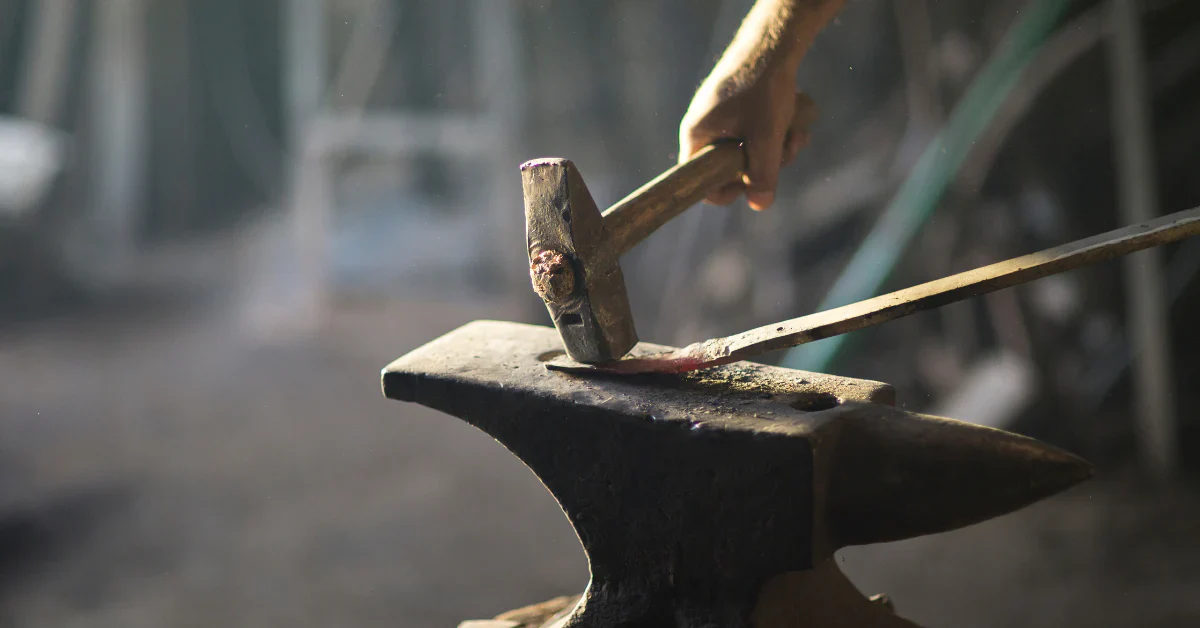Blacksmiths are skilled artisans who turn raw metal into useful and beautiful items. They shape, forge, and finish metal, making everything from tools to sculptures. In Australia, blacksmiths are key in industries like agriculture and construction.
Today, blacksmithing blends old techniques with new ideas. To be good at it, you need skills like knowing about metals, being physically strong, and creative. Let’s look at how these skills are used and why blacksmithing matters today.
Understanding the Role of a Blacksmith
The role of a blacksmith has changed a lot over time. In the past, blacksmiths were key to society’s growth. They made tools and weapons for many cultures.
The history of blacksmithing shows how old techniques led to today’s methods. This has shaped craftsmanship for many years.
Historical Context of Blacksmithing
Blacksmithing started in ancient times. Skilled artisans were vital to their communities. They made important items like farming tools and weapons.
The use of iron was a big step in blacksmithing’s history. It made tools stronger and more effective. The Romans and Egyptians were known for their metalworking skills, influencing future blacksmiths.
The Evolution of Blacksmithing Techniques
Blacksmithing techniques have changed a lot. At first, it was all about manual work. But the Industrial Revolution brought big changes.
Now, blacksmiths use modern tools like power hammers and welding machines. This makes their work more precise and efficient.
Learning about these changes helps us see how the craft has evolved. Today, blacksmiths mix old skills with new technology. They create unique metalwork that is both functional and artistic.
Core Responsibilities of a Blacksmith
Being a blacksmith means doing many important tasks. It’s a mix of skill and creativity. They shape metal for use and make art pieces. Each task needs special techniques and knowledge of materials.
Shaping Metal for Functional Use
Functional blacksmithing is about making useful items. This includes tools, parts for machines, and building parts. Blacksmiths work with hot metal to make things strong and lasting.
They make things like horseshoes, knives, and machine parts. This work is key in many fields. It helps make and fix important tools and structures.
Crafting Artistic Metalwork
Artistic blacksmithing is all about creativity and beauty. Blacksmiths create decorative items, sculptures, and custom pieces for people. They use their skills to turn metal into beautiful works.
They make things like fancy gates and special furniture. This shows how metal can be turned into something beautiful and elegant.
Essential Tools Used by Blacksmiths
Starting in blacksmithing means knowing the key tools. Blacksmithing tools vary, each crucial for metal work. The right tools can make work better and faster. We’ll look at the must-have tools and how new tools differ from old ones.
Overview of Blacksmithing Tools
Anvils, hammers, tongs, and forges are basic. Each tool has its role in metal shaping. Anvils are for hammering, hammers for precision, tongs for safety, and forges for heat.
Modern vs Traditional Tools
Traditional tools like hand-forged hammers and coal forges are still used. But, modern tools like gas forges and electric hammers offer better speed and control. These changes help blacksmiths work faster and create more.
Skills Required to Become a Successful Blacksmith
To be a great blacksmith, you need many skills. Learning these skills improves your craft and boosts your creativity. Skills like metallurgy, physical strength, and design are key. They make your work both beautiful and useful.
Technical Skills in Metallurgy
Knowing metallurgy is crucial for blacksmiths. It helps them understand how metals react to heat and how to mix them. This knowledge makes sure their work lasts long and works well.
Physical Skills and Stamina
Blacksmithing is hard work. You need lots of stamina and strength. It involves a lot of lifting and working in hot conditions. Staying fit is important to do the job well all day.
Creative Skills in Design
In a competitive world, being creative sets you apart. Blacksmiths who mix technical skills with creativity make unique pieces. This not only makes their work more appealing but also attracts more customers.
The Art of Forging: Techniques and Methods
Forging in blacksmithing involves many techniques to shape metal. These techniques are key to making both functional and artistic items. Each method has its own benefits, fitting different project needs.
Different Forging Techniques Explained
Hammer forging, hand forging, and power hammering are common methods. Hammer forging uses a hammer to shape metal, allowing for detailed work. Hand forging requires manual skill, creating a bond between the artist and metal.
Power hammering uses machines for consistent force, speeding up work on big projects.
The Importance of Heat Control
Heat control is vital in blacksmithing. It’s important to heat metals to the right temperature for shaping. This ensures they can be molded without losing strength.
Keeping the metal at the right temperature is crucial. It prevents breaks and ensures evenness. Skilled blacksmiths use forges to control heat, working their materials well.
Blacksmithing as a Craft in Australia
The blacksmithing scene in Australia is vibrant, thanks to a passionate community. Local guilds and yearly showcases help connect artisans. This community welcomes both new and experienced blacksmiths, encouraging creativity and skill growth.
The Blacksmith Community in Australia
Across the country, organisations support the blacksmithing culture. Workshops, events, and exhibitions showcase blacksmiths’ talents. These events foster collaboration and learning.
Experienced blacksmiths mentor newcomers, ensuring the craft’s future. This mentorship is crucial for the craft’s growth.
Opportunities for Aspiring Blacksmiths
Aspiring blacksmiths in Australia have many opportunities. Educational programs teach essential skills. Apprenticeships offer hands-on experience with skilled craftsmen.
Starting a business in blacksmithing is also an option. It combines creativity with entrepreneurship, attracting dedicated individuals.
Conclusion
Blacksmithing is a craft that has been around for ages. It’s full of skill, creativity, and history. It’s used for both practical and artistic purposes. This craft is important in today’s world and in Australia’s artistic communities.
The tools used in blacksmithing are key to its success. They help shape metal into useful and beautiful items. This shows the craft’s value and its place in our culture.
The future of blacksmithing looks bright. New technology and a love for handmade items are helping it grow. More people are using green materials and methods, which could change blacksmithing a lot.
This change might attract a new wave of blacksmiths. They will mix old ways with new ideas. This could make blacksmithing even more exciting.
Blacksmithing connects us to our past and to making things by hand. By supporting blacksmiths, we help keep this craft alive. It adds beauty and skill to our lives and opens up new possibilities.


